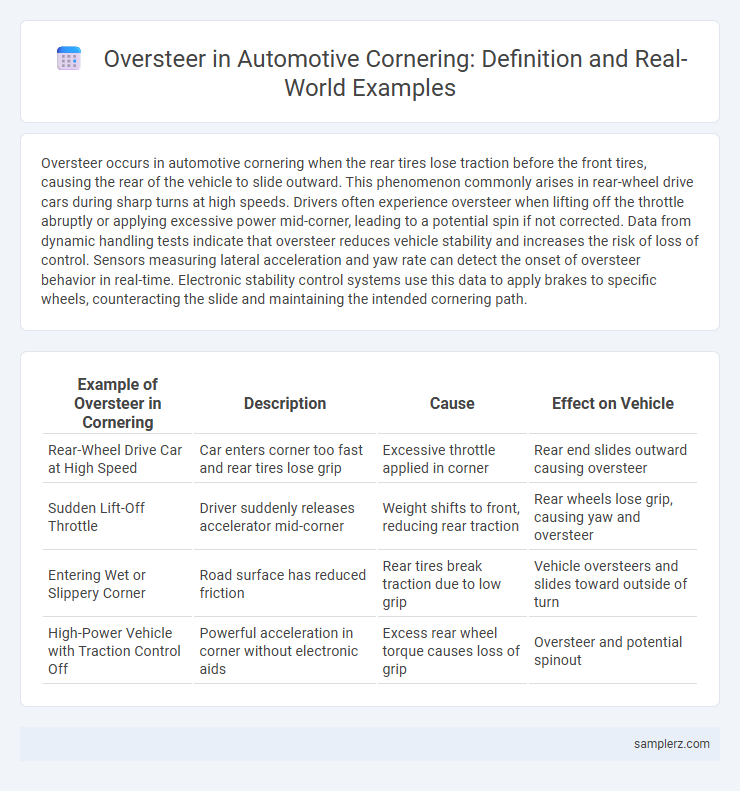Oversteer occurs in automotive cornering when the rear tires lose traction before the front tires, causing the rear of the vehicle to slide outward. This phenomenon commonly arises in rear-wheel drive cars during sharp turns at high speeds. Drivers often experience oversteer when lifting off the throttle abruptly or applying excessive power mid-corner, leading to a potential spin if not corrected. Data from dynamic handling tests indicate that oversteer reduces vehicle stability and increases the risk of loss of control. Sensors measuring lateral acceleration and yaw rate can detect the onset of oversteer behavior in real-time. Electronic stability control systems use this data to apply brakes to specific wheels, counteracting the slide and maintaining the intended cornering path.
Table of Comparison
| Example of Oversteer in Cornering | Description | Cause | Effect on Vehicle |
|---|---|---|---|
| Rear-Wheel Drive Car at High Speed | Car enters corner too fast and rear tires lose grip | Excessive throttle applied in corner | Rear end slides outward causing oversteer |
| Sudden Lift-Off Throttle | Driver suddenly releases accelerator mid-corner | Weight shifts to front, reducing rear traction | Rear wheels lose grip, causing yaw and oversteer |
| Entering Wet or Slippery Corner | Road surface has reduced friction | Rear tires break traction due to low grip | Vehicle oversteers and slides toward outside of turn |
| High-Power Vehicle with Traction Control Off | Powerful acceleration in corner without electronic aids | Excess rear wheel torque causes loss of grip | Oversteer and potential spinout |
Understanding Oversteer in Automotive Cornering
Oversteer occurs when the rear tires lose traction during cornering, causing the vehicle's rear to swing outward and the car to turn more sharply than intended. This phenomenon is common in rear-wheel-drive vehicles and can be induced by excessive throttle application or abrupt steering inputs. Mastering throttle control and smooth steering adjustments helps drivers maintain stability and prevent oversteer in high-speed cornering scenarios.
Causes of Oversteer During Turns
Oversteer during cornering occurs when the rear tires lose traction before the front tires, causing the vehicle's rear to swing outward. Common causes include excessive throttle input, abrupt steering, and a rear-weight bias that unsettles the balance between front and rear grip. Underinflated or worn rear tires and road surface irregularities also contribute significantly to oversteer dynamics.
Real-World Examples of Oversteer
Oversteer occurs when the rear tires lose grip during cornering, causing the rear of the vehicle to swing outward, often seen in rear-wheel-drive sports cars like the BMW M3 and Mazda MX-5. Professional rally drivers frequently experience controlled oversteer on loose gravel or snow to navigate tight corners at high speed. In everyday driving, oversteer can be observed when a driver sharply turns a rear-wheel-drive car on wet or icy roads, resulting in the car's tail fishtailing.
Oversteer vs. Understeer: Key Differences
Oversteer occurs when the rear tires lose traction during cornering, causing the rear of the vehicle to swing outward and the car to rotate more sharply than intended. In contrast, understeer happens when the front tires lose grip, resulting in the vehicle continuing straight despite steering input, making the car resist turning. Understanding the dynamics of oversteer versus understeer is crucial for automotive performance tuning and driver safety in high-speed cornering scenarios.
Oversteer in Rear-Wheel-Drive Vehicles
Oversteer in rear-wheel-drive vehicles occurs when the rear tires lose traction during cornering, causing the rear end to slide outward. This phenomenon is often observed in high-performance cars with powerful engines delivering torque to the rear wheels, especially during aggressive acceleration or sharp turns. Drivers can counteract oversteer by gently steering into the slide while modulating throttle input to regain control and maintain the intended racing line.
Professional Drivers’ Experiences with Oversteer
Professional drivers often encounter oversteer when aggressively cornering at high speeds, requiring precise throttle control and counter-steering to maintain vehicle stability. Track data from endurance races highlights how oversteer can be intentionally induced to achieve faster lap times by exploiting rear tire grip limits. Driver telemetry shows experienced racers modulate inputs to balance oversteer dynamics, enhancing cornering performance without compromising traction.
Oversteer Scenarios in Wet Road Conditions
Oversteer in wet road conditions often occurs when the rear tires lose traction during cornering, causing the rear end to slide outward. This scenario is common in sharp turns at higher speeds where excessive throttle or abrupt steering inputs overwhelm the tire grip on slippery surfaces. Understanding vehicle dynamics in these situations helps drivers maintain control by countersteering and modulating throttle input to regain stability.
Vehicle Dynamics and Oversteer Instances
Oversteer occurs during cornering when the rear tires lose grip, causing the vehicle's rear to swing outward, often seen in high-speed turns on wet or slick surfaces. This phenomenon is influenced by factors such as weight distribution, throttle input, and tire traction, demanding precise driver control to correct the vehicle's trajectory. Sports cars with rear-wheel drive layouts frequently exhibit oversteer characteristics, requiring understanding of vehicle dynamics to maintain stability and optimize handling performance.
How to Recover from Oversteer in a Corner
Oversteer in cornering occurs when the rear tires lose grip, causing the vehicle's rear to slide outward and potentially spin. To recover from oversteer, steer gently into the direction of the skid while modulating throttle input to regain rear tire traction without abrupt movements. Maintaining smooth, controlled steering adjustments and avoiding sudden braking helps stabilize the vehicle and prevent loss of control during high-speed cornering.
Preventative Measures to Avoid Oversteer
Oversteer occurs when the rear tires lose grip during cornering, causing the vehicle to turn more sharply than intended and potentially spin out. Maintaining proper tire pressure, ensuring balanced weight distribution, and utilizing electronic stability control systems can significantly reduce the risk of oversteer. Drivers should also moderate throttle input and avoid abrupt steering corrections to preserve traction and maintain vehicle control.

example of oversteer in cornering Infographic
 samplerz.com
samplerz.com